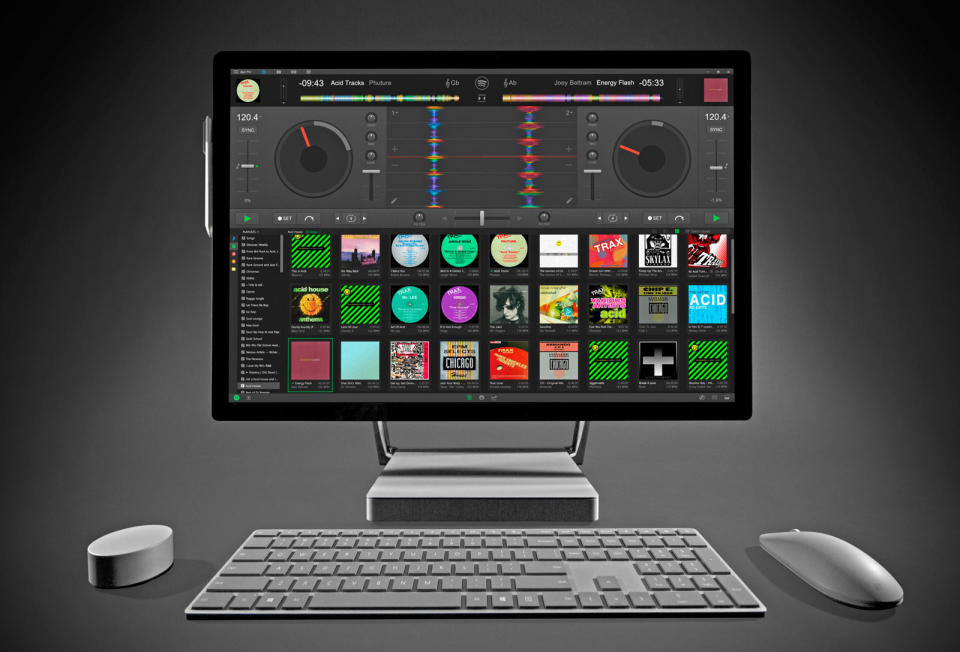Algoriddim's djay Pro finally makes the move to Windows
It almost seems like the Surface Studio was meant for this.

After a short few months in beta, Algoriddim's djay Pro has finally arrived as a native Windows 10 app. Prior to this, the Apple-centric software added Android to its roster of mobile devices, including the iPad Pro, but otherwise hasn't been available on bigger touchscreens. The extensive line of Windows hybrids seem well-suited to hands-on digital DJing, but when you consider the Surface Studio, you have a monster of an interface and a match made in heaven.
For the unfamiliar, djay Pro is a digital DJ interface that gives you complete mixing control, with up to four virtual decks and waveform views, sound effects, filters and a crossfader. You can pull from your own local library of tunes in addition to the entire Spotify catalog to suit any occasion. The Windows 10 release of djay Pro, however, isn't exactly the same as previous versions, at least not yet. The video mixing feature that allows you to blend visuals with your music — assuming you're really good at multitasking — didn't make it to this release. It's on the roadmap, but you'll have to wait a while.
Algoriddim didn't rebuild the application from the ground up for this new platform, it used Windows Bridge for iOS to translate djay Pro into a native Windows 10 app. That means it's just one codebase for the product across all platforms, with just a few local tweaks to adapt to the Windows environment. There may still be a few bugs to work out, but that's par for the course with a fresh new release.

If you've used djay Pro before, you'll be hard pressed to notice any changes here, so there's no learning curve using the app on Windows, aside from the machine's OS, of course. You can finally break from free from tablets to utilize the full touchscreen interface, and while a laptop screen does have a good bit of real estate, the kicker here is the ability to use the Surface Studio and its massive 28-inch PixelSense screen as a DJ workstation.
The Studio seems like a breath of fresh air, being able to use the app with so much screen space. Even with the decks displayed, you still get a rich and colorful display area for your digital library's album icons or track lists. With Spotify integration, you can also search through the vast online libray (with a peripheral or spacious onscreen keyboard) and get multiple columns showing artist/album results, Match recommendations (based on BPM, key and music style) and your current queue. To put tunes on deck, you can drag and drop selections using your fingers and the Pen or by scrolling though options using the Dial interface and clicking to select.

Dial support is still scarce, making its addition here a big step forward. This includes on-screen location sensing, with some incredibly useful interactions, such as scrolling through tracks quickly or using it to control the crossfader or deck. You can drop it onto the track list (assuming your screen is tilted enough that gravity doesn't take over) and quickly scroll through selections, then pick it up and move it onto one of the active decks or waveforms and scrub through the track. This may sound useful in theory, but trying to backspin with the Dial isn't really something I'd recommend, based on my brief experience with it. For crossfading, it seems to work best with the Dial on a table (which is the setting it defaults to here) and not directly on top of the onscreen fader, but it seems like an improvement over the touchscreen option.
As long as your PC or mobile device has a USB interface, you can also use one of over 60 MIDI controllers with the djay Pro app for Windows 10, providing a more three-dimensional tactile experience with the ability to map hardware controls to software actions. After trying this on the Surface Studio though, I could see the argument for just using a large touchscreen without too many drawbacks.

Algoriddim's djay Pro arrives today in the Windows Store for $49.99, with free trials available if you want to take it for a test drive first. You'll need a machine running Windows 10 Desktop Version 1607 or later.













